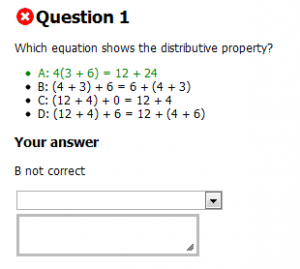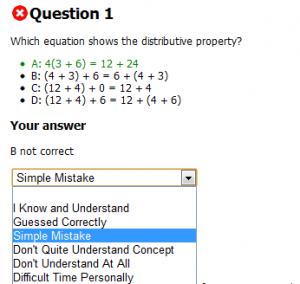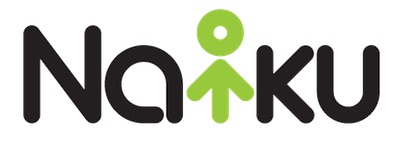
Student Reflection
When I do professional development for teachers and administrators on how to incorporate Naiku into their formative assessment practice, the part that gets them most excited is when I talk about student reflection. Merriam-Webster.com defines reflection as “a thought, idea, or opinion formed or a remark made as a result of meditation.” Here, I define reflection as a process by which students engage in metacogntive thinking about what they have done, what they are doing, and what they will do in the future. This type of thinking helps students better identify what they know, what they don’t know, and what they plan to do to learn what they don’t know.
I wrote about the importance of feedback in the formative assessment process in an earlier post. Reflection is basically a great way for students to give feedback to themselves as well as to their teachers. A simple way to get students to engage in this metacognitive process is to have them reflect on their answers during and after test-taking.
Reflection During Assessment
Reflection can occur during the test-taking experience by asking students to mark or “flag” their answers for later review. Students can also be asked to rate the confidence in the answers. For example, Chen (2009) found that students who marked their answers (i.e., flagged their answers for later review) during test-taking and were given metacognitively-evaluated feedback performed better on a vocabulary and reading comprehension test. Medium-ability students showed the greatest benefit for this activity, which is encouraging since that group was targeted to have the most potential for improvement.
Reflection Post Assessment
After the assessment has been scored, another way to engage students in metacognition is to have them reflect on their answers. Specifically, students can be asked to provide a rationale for why they answered the question incorrectly (e.g., “I guessed”, “I made a mistake”, “I don’t know the concept”). While (most importantly), this provides students a way to practice metacognition, teachers can also be provided with very useful information about their students. For example, aggregated over time, these reflections can tell a teacher whether the student has a tendency to make simple mistakes. Knowing this, the teacher can adjust instruction or help the student adjust studying tactics.
How Student Reflection Works in Naiku
So what gets educators so excited when I talk about student reflection? Most were already using this formative assessment practice in some form or another.
First, what gets them excited is the fact that reflection is so easy to do in Naiku. Students can reflect on the entire assessment and on individual test questions. For example, a teacher may ask the students to reflect on how they prepared for the assessment and whether it was effective. For each test question, students are asked to select a “reflection tag” to indicate why they answered the question correctly or incorrectly. The first image belows shows a screenshot of a test item that was answered incorrectly by a student. There is a drop-down list of reflections from which students can select. The second image shows the list of reflection tags that can be selected. There is an open text box for students to further explain their reflection. For example, in the text box, students can explain to themselves why they made a simple mistake. These self-explanations not only give students a way to leave notes or study aides for themselves, they are an excellent way to further engage students in metacognitive thinking. Students refer to this feature of Naiku as “item journaling.”


Second, what gets educators (and students) excited about the Naiku Student Reflection feature is that it is immediate. Right after the test or quiz is taken, students immediately get their results and can begin the reflection process. They no longer have to wait days or weeks (when test results are usually returned when tests aren’t taken on Naiku) to start the metacognitive reflection process. With Naiku, they can do it immediately (in the same class period), when their answers and the test is still fresh in their minds. This instant feedback of test result and reflection information allows teachers to respond quickly to each student’s areas of strength and need.
Reflection and Test-taking
In summary, reflection is an effective way to engage students in metacognition. It can be used during test-taking by asking students to mark or rate their answers. It can also be used after test-taking by asking students to give rationales for their wrong answers. Both reflection techniques help students learn through testing.
When students engage in reflection, they are essentially taking ownership of their own learning. They are helping themselves be engaged students and better learners. Additionally, when they reflect, they are strengthening the student-teacher connection. When they reflect and are honest with themselves, they are providing valuable feedback to their teachers. Knowing this information, teachers can better tailor instruction to help each and every individual student.
Engaged students taking ownership of their own learning leads to a more effective and efficient system. Teachers love to work with students who have a thirst for knowledge.

